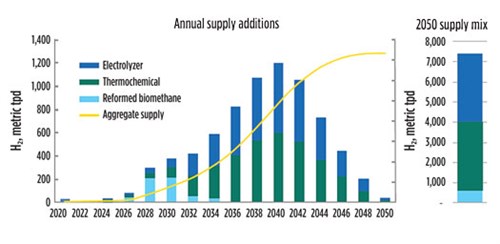Editorial Comment
H2 blending into gas networks for “greener” methane
Facing regulatory uncertainty, competition from renewable energy and increasing calls for decarbonization, natural gas pipeline operators are studying the blending of hydrogen (H2) into their networks to produce lower-carbon methane and test their equipment’s capability for handling H2/methane blends.
In Europe, Australia and the U.S., trial projects are studying blends of 5%–20% H2 and methane for use in regional gas networks. For example, a group of 23 European gas infrastructure companies plan to build a dedicated, affordable H2 transport network from modified gas infrastructure. This project, referred to as the European Hydrogen Backbone, is set to span 7,200 mi (11,600 km) by 2030 and 24,670 mi (39,700 km) across 21 countries by 2040.
Meanwhile, Australia’s natural gas pipeline owners are looking to future-proof their A$75 B of assets by conducting tests to blend H2 with natural gas. Some Australian states are pushing for a 10% H2 blend in gas pipelines by 2030, which can be safely accommodated without modification to infrastructure or appliances.
The U.S. government’s HyBlend project is examining the long-term effects of H2 at different blends on metal and polymer piping and pipeline materials to determine the costs of upgrading existing pipeline networks to make the shift. Technical challenges of blending H2 into gas networks include the risk of leakage related to possible H2 embrittlement of metal, the risk of explosion from using H2 in appliances at blends of greater than 25%, compatibility issues with existing compressors, and H2’s lower energy density compared with natural gas. Blends of up to 15% H2 are anticipated to require only moderate modifications to infrastructure, but blends of 20% H2 and higher could present more difficult conversion challenges.
Furthermore, Sempra Energy is carrying out a series of demonstration projects in the U.S. to test various blends of H2 in pipeline segments of polyethylene, steel and a combination of the two. Sempra subsidiary Southern California Gas Co. is also conducting a study with technology developed by HyET Hydrogen to strip and compress pure H2 from natural gas blends (FIG. 1).
 |
|
FIG. 1. Projected buildout of California H2 supply, 2020–2050. Source: University of California–Irvine. |
For more H2 technology and projects news, please subscribe to our new technical journal, H2Tech, and visit H2-Tech.com. GP




Comments